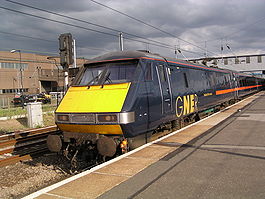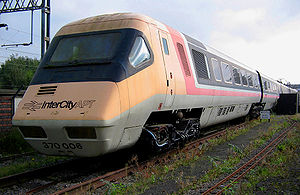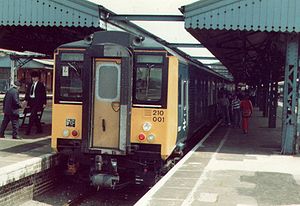
BREL
Encyclopedia

Railway systems engineering
Railway systems engineering is a multi-faceted engineering discipline dealing with the design, construction and operation of all types of railway systems....
division of British Rail
British Rail
British Railways , which from 1965 traded as British Rail, was the operator of most of the rail transport in Great Britain between 1948 and 1997. It was formed from the nationalisation of the "Big Four" British railway companies and lasted until the gradual privatisation of British Rail, in stages...
, until the design and building of trains in the UK was privatised in 1993. On 31 October 1969, the company was incorporated as British Rail Engineering Limited.
Main products
The vast majority of BREL's output was for British RailBritish Rail
British Railways , which from 1965 traded as British Rail, was the operator of most of the rail transport in Great Britain between 1948 and 1997. It was formed from the nationalisation of the "Big Four" British railway companies and lasted until the gradual privatisation of British Rail, in stages...
. These included the British Rail Mark 2
British Rail Mark 2
The Mark 2 family of railway carriages were British Rail's second design of carriages. They were built by British Rail workshops between 1964 and 1975...
and British Rail Mark 3
British Rail Mark 3
British Rail's third design of standard carriage was designated 'Mark 3' , and was developed primarily for the InterCity 125 High Speed Train...
carriages, the latter being built either for locomotive haulage or part of Inter City 125 diesel High Speed Trains. BREL also built the NIR 80 Class
NIR 80 Class
The Class 80 is a type of diesel electric multiple unit in service with Northern Ireland Railways.-History:By the early 1970s the MEDs and units inherited from the GNR had been in service for 20 years, and the MPDs for 10 years. To replace these increasingly life-expired units, Northern Ireland...
diesel-electric multiple units for Northern Ireland Railways
Northern Ireland Railways
NI Railways, also known as Northern Ireland Railways and for a brief period of time, Ulster Transport Railways , is the railway operator in Northern Ireland...
. Other Mark 3 derived vehicles included the British Rail Class 150
British Rail Class 150
The British Rail Class 150 "Sprinter" diesel multiple units were built by BREL from 1984-87. A total of 137 units were built in three main subclasses, replacing many of the earlier first-generation "Heritage" DMUs.- Background :...
diesel multiple units built in the 1980s, plus numerous electric multiple units (such as Class 313
British Rail Class 313
British Rail Class 313 electric multiple units were built by BREL at York Works between February 1976 and April 1977 and were the first second-generation EMUs to be constructed for British Rail...
and Class 317
British Rail Class 317
The British Rail Class 317 alternating current electric multiple units were built by BREL York in two batches, from 1981-82 and 1985-87. They were the first of several classes of British Rail EMU to be based on the all-steel Mark 3 bodyshell, departing from the "PEP"-aluminium design which had...
).
BREL had limited success in the export market, notably with Mark 2 and Mark 3 carriages for Irish Rail plus some carriages for Taiwan
Taiwan
Taiwan , also known, especially in the past, as Formosa , is the largest island of the same-named island group of East Asia in the western Pacific Ocean and located off the southeastern coast of mainland China. The island forms over 99% of the current territory of the Republic of China following...
.
Other products


Advanced Passenger Train
The Advanced Passenger Train was an experimental tilting High Speed Train developed by British Rail during the 1970s and early 1980s....
(APT) tilting
Tilting train
A tilting train is a train that has a mechanism enabling increased speed on regular rail tracks. As a train rounds a curve at speed, objects inside the train experience centrifugal force. This can cause packages to slide about or seated passengers to feel squashed by the outboard armrest due to...
during the 1970s and early 1980s. The class 210 were externally very similar to the first batch of Class 317
British Rail Class 317
The British Rail Class 317 alternating current electric multiple units were built by BREL York in two batches, from 1981-82 and 1985-87. They were the first of several classes of British Rail EMU to be based on the all-steel Mark 3 bodyshell, departing from the "PEP"-aluminium design which had...
EMUs, but half of the forward carriage was taken up by the engine room. Power was provided by an above-floor diesel engine driving a generator to power traction motors on the axles. A single engine was fitted at one end of the train, and the trains operated in a push-pull configuration
Push-pull train
Push–pull is a mode of operation for locomotive-hauled trains allowing them to be driven from either end.A push–pull train has a locomotive at one end of the train, connected via some form of remote control, such as multiple-unit train control, to a vehicle equipped with a control cab at the other...
.
Locations
BREL operated train building factories at several sites, with the major production centres being at CreweCrewe
Crewe is a railway town within the unitary authority area of Cheshire East and the ceremonial county of Cheshire, England. According to the 2001 census the urban area had a population of 67,683...
, Derby
Derby Works
The Midland Railway Locomotive Works, known locally as "the loco" comprised a number of British manufacturing facilities in Derby building locomotives and, initially, rolling stock in Derby, UK.-Early days:...
, Doncaster
Doncaster Works
Doncaster railway works is in the town of Doncaster, South Yorkshire, England.Always referred to as "the Plant", it was established by the Great Northern Railway in 1853, replacing the previous works in Boston and Peterborough...
and York
York
York is a walled city, situated at the confluence of the Rivers Ouse and Foss in North Yorkshire, England. The city has a rich heritage and has provided the backdrop to major political events throughout much of its two millennia of existence...
. The historic site at Wolverton
Wolverton
Wolverton is part of Milton Keynes, Buckinghamshire, England.Wolverton may also refer to:Places in England:*Wolverton, Dorset*Wolverton, Kent*Wolverton, Hampshire*Wolverton, Shropshire*Wolverton, WarwickshirePlaces in the United States:...
in Milton Keynes
Milton Keynes
Milton Keynes , sometimes abbreviated MK, is a large town in Buckinghamshire, in the south east of England, about north-west of London. It is the administrative centre of the Borough of Milton Keynes...
was progressively run down until the 1980s before finally being relegated to maintenance duties only.
However, not all British Rail rolling stock was built in-house; Metro Cammell
Metro Cammell
The Metropolitan Cammell Carriage and Wagon Company was a Birmingham, England based manufacturer of railway carriages and wagons, based in Saltley and subsequently Washwood Heath....
, Brush Traction
Brush Traction
This article is about a British rail-locomotive maker. For the Detroit auto-maker, see Brush Motor Car CompanyBrush Traction is a manufacturer and maintainer of railway locomotives, part of the FKI group , based at Loughborough in Leicestershire, England situated alongside the Midland Main Line.-...
and Metropolitan-Vickers
Metropolitan-Vickers
Metropolitan-Vickers, Metrovick, or Metrovicks, was a British heavy electrical engineering company of the early-to-mid 20th century formerly known as British Westinghouse. Highly diversified, they were particularly well known for their industrial electrical equipment such as generators, steam...
amongst others manufactured rolling stock, although in general it was built to BREL specifications.
Privatisation
In 1989 it was purchased by the Swiss-Swedish conglomerate ABB (ASEA-Brown Boveri) 40% and Trafalgar HouseTrafalgar House (company)
Trafalgar House Public Limited Company was a British conglomerate with interests in property investment, property development, engineering, construction, shipping, hotels, energy and publishing...
40% and a MEBO (Management-Employee Buy-Out) of 20% forming BREL Ltd. It was latterly bought out by ABB to form the subsidiary ABB Transportation Ltd.
The privatisation of British Rail
Privatisation of British Rail
The privatisation of British Rail was set in motion when the Conservative government enacted, on 19 January 1993, the British Coal and British Rail Act 1993 . This enabled the relevant Secretary of State to issue directions to the relevant Board...
caused a disastrous hiatus in the ordering of new rolling stock, which ultimately led to the almost complete collapse of the rolling stock industry in the UK. Following the demise of the York works and the closure of the Metro-Cammell (now Alstom
Alstom
Alstom is a large multinational conglomerate which holds interests in the power generation and transport markets. According to the company website, in the years 2010-2011 Alstom had annual sales of over €20.9 billion, and employed more than 85,000 people in 70 countries. Alstom's headquarters are...
) plant in Birmingham in 2005, only the former BREL facility in Derby
Derby Carriage and Wagon Works
Derby Carriage and Wagon Works was built by the Midland Railway in Derby, England. The plant has been through many changes of ownership and is currently owned by Bombardier Transportation, a subsidiary of Bombardier Inc. of Canada. As of 2011 it is the only remaining passenger rolling stock...
remains as a major manufacturer of rolling stock in the United Kingdom.
Like Metro Cammell
Metro Cammell
The Metropolitan Cammell Carriage and Wagon Company was a Birmingham, England based manufacturer of railway carriages and wagons, based in Saltley and subsequently Washwood Heath....
, BREL has also helped in the planning, design and on occasion, the manufacturing of various London Underground
London Underground
The London Underground is a rapid transit system serving a large part of Greater London and some parts of Buckinghamshire, Hertfordshire and Essex in England...
stock over the years.
See also
- High Speed TrainHigh Speed TrainThere are three types of trains in Britain that have been traditionally viewed as high speed trains:* Advanced Passenger Train - Tilting trains which never entered into regular revenue-earning service....
- Advanced Passenger TrainAdvanced Passenger TrainThe Advanced Passenger Train was an experimental tilting High Speed Train developed by British Rail during the 1970s and early 1980s....
- InterCity 225InterCity 225The InterCity 225 is a locomotive-hauled domestic train in the United Kingdom, comprising a Class 91 electric locomotive, nine Mark 4 coaches and a Driving Van Trailer...
- British RailBritish RailBritish Railways , which from 1965 traded as British Rail, was the operator of most of the rail transport in Great Britain between 1948 and 1997. It was formed from the nationalisation of the "Big Four" British railway companies and lasted until the gradual privatisation of British Rail, in stages...
- London Underground 1986 StockLondon Underground 1986 StockThe London Underground 1986 Tube Stock consisted of prototype electric multiple units that led to the development of the 1992 Stock. Two prototypes were built by Metro-Cammell, and the third by BREL ....

